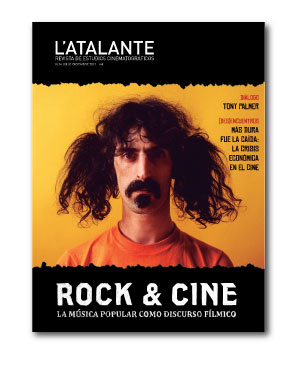Publicado 01.07.2012
Palabras clave
- música rock,
- hooliganismo,
- identidad nacional,
- narrativa épica,
- realismo social
Cómo citar
Ramos Gay, I. (2012). Chavs, Yobs & ASBOS: rock y sociedad en el cine contemporáneo británico. L’Atalante. Revista De Estudios cinematográficos, (14), 50–57. https://doi.org/10.63700/57
Resumen
El objeto de este artículo es analizar la representación de la violencia hooligan a través de su expresión musical en el cine hooligan contemporáneo británico (1995-2009). Además de testimonio autentificador de la reconstrucción cinematográfica de la historia reciente de Gran Bretaña, el uso del rock como banda sonora contribuye a la glamourización de la violencia juvenil en el pasado, al tiempo que fomenta la identificación entre el sentido épico y militar del acontecimiento musical y deportivo. Concluiremos señalando que la diversidad de tendencias y estilos musicales de bandas británicas mimetiza la idiosincrasia plural y mestiza de las hinchadas, cuya disparidad es únicamente reconciliada por los colores del club y de la identidad nacional.Descargas
Los datos de descargas todavía no están disponibles.
Citas
BODIN, Dominique, ROBÈNE, Luc, y HÉAS Stéphane (2005). Le hooliganisme entre genèse et modernité. Vingtième siècle. Revue d’histoire, 85, 61-83.
DAVIS, Andrew (1998). Youth Gangs, Masculinity and Violence in Late Victorian Manchester and Salford. Journal of Social History, 2, 349-369.
DUNNING, Eric, MURPHY, Patrick, y WILLIAMS, John (1986). Spectator Violence at Football Matches: Towards a Sociological
Explanation. The British Journal of Sociology, 2, 221-244.
GILBERT, Francis (2006). Yob Nation. The Truth About Britain’s Yob Culture. Londres: Portrait.
KING, Anthony (1997). The Postmodernity of Football Hooliganism. The British Journal of Sociology, 4, 576-593.
— (1998). The Rise of the Juvenile Delinquency in England 1780-1840: Changing Patterns of Perception and Prosecution. Past & Present, 160, 116-166.
LOWLES, Nick, y NICHOLLS, Andy (2005). The A-Z of Britain’s Football Hooligan Gangs. Reading: Milo Books, 2 vols.
MANDLER, Peter (2006). The English National Character. The History of an Idea from Edmund Burke to Tony Blair. New Haven y Londres: Yale UP.
MARSH, Peter E. (1977). Football Hooliganism: Fact or Fiction. British Journal of Law and Society, 2, 256-259.
PAXMAN, Jeremy (1998). The English. Londres: Penguin.
ROARBURG, Alland (1980). Factors Precipitating Fan Violence: A Comparison of Professional Soccer in Britain and North America. The British Journal of Sociology, 2, 265-276.
SAVAGE, Jon (2007). Teenage. The Creation of Youth 1875-1945. Londres: Pimlico.
TAYLOR, David (2010). Hooligans, Harlots, and Hangmen. Crime and Punishment in Victorian Britain. Santa Barbara, Denver, Oxford: Praeger.
DAVIS, Andrew (1998). Youth Gangs, Masculinity and Violence in Late Victorian Manchester and Salford. Journal of Social History, 2, 349-369.
DUNNING, Eric, MURPHY, Patrick, y WILLIAMS, John (1986). Spectator Violence at Football Matches: Towards a Sociological
Explanation. The British Journal of Sociology, 2, 221-244.
GILBERT, Francis (2006). Yob Nation. The Truth About Britain’s Yob Culture. Londres: Portrait.
KING, Anthony (1997). The Postmodernity of Football Hooliganism. The British Journal of Sociology, 4, 576-593.
— (1998). The Rise of the Juvenile Delinquency in England 1780-1840: Changing Patterns of Perception and Prosecution. Past & Present, 160, 116-166.
LOWLES, Nick, y NICHOLLS, Andy (2005). The A-Z of Britain’s Football Hooligan Gangs. Reading: Milo Books, 2 vols.
MANDLER, Peter (2006). The English National Character. The History of an Idea from Edmund Burke to Tony Blair. New Haven y Londres: Yale UP.
MARSH, Peter E. (1977). Football Hooliganism: Fact or Fiction. British Journal of Law and Society, 2, 256-259.
PAXMAN, Jeremy (1998). The English. Londres: Penguin.
ROARBURG, Alland (1980). Factors Precipitating Fan Violence: A Comparison of Professional Soccer in Britain and North America. The British Journal of Sociology, 2, 265-276.
SAVAGE, Jon (2007). Teenage. The Creation of Youth 1875-1945. Londres: Pimlico.
TAYLOR, David (2010). Hooligans, Harlots, and Hangmen. Crime and Punishment in Victorian Britain. Santa Barbara, Denver, Oxford: Praeger.

